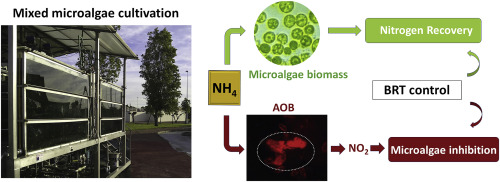Water Research ( IF 11.4 ) Pub Date : 2020-01-14 , DOI: 10.1016/j.watres.2020.115499 J. González-Camejo , P. Montero , S. Aparicio , M.V. Ruano , L. Borrás , A. Seco , R. Barat

|
Outdoor microalgae cultivation systems treating anaerobic membrane bioreactor (AnMBR) effluents usually present ammonium oxidising bacteria (AOB) competition with microalgae for ammonium uptake, which can cause nitrite accumulation. In literature, nitrite effects over microalgae have shown controversial results. The present study evaluates the nitrite inhibition role in a microalgae-nitrifying bacteria culture.
For this purpose, pilot- and lab-scale assays were carried out. During the continuous outdoor operation of the membrane photobioreactor (MPBR) plant, biomass retention time (BRT) of 2 d favoured AOB activity, which caused nitrite accumulation. This nitrite was confirmed to inhibit microalgae performance. Specifically, continuous 5-d lab-scale assays showed a reduction in the nitrogen recovery efficiency by 32, 42 and 80% when nitrite concentration in the culture accounted for 5, 10 and 20 mg N·L−1, respectively. On the contrary, short 30-min exposure to nitrite showed no significant differences in the photosynthetic activity of microalgae under nitrite concentrations of 0, 5, 10 and 20 mg N·L−1.
On the other hand, when the MPBR plant was operated at 2.5-d BRT, the nitrite concentration was reduced to negligible values due to increasing activity of microalgae and nitrite oxidising bacteria (NOB). This allowed obtaining maximum MPBR performance; i.e. nitrogen recovery rate (NRR) and biomass productivity of 19.7 ± 3.3 mg N·L−1·d−1 and 139 ± 35 mg VSS·L−1·d−1, respectively; while nitrification rate (NOxR) reached the lowest value (13.5 ± 3.4 mg N·L−1·d−1).
Long BRT of 4.5 d favoured NOB growth, avoiding nitrite inhibition. However, it implied a decrease in microalgae growth and the accumulation of nitrate in the MPBR effluent. Hence, it seems that optimum BRT has to be within the range 2–4.5 d in order to favour microalgae growth in comparison to those of AOB and NOB.
中文翻译:

微藻与硝化细菌竞争引起的亚硝酸盐抑制微藻
处理厌氧膜生物反应器(AnMBR)废水的室外微藻培养系统通常会产生铵氧化细菌(AOB)与微藻争夺铵吸收,这会导致亚硝酸盐积累。在文献中,亚硝酸盐对微藻的作用已显示出争议的结果。本研究评估了亚硝酸盐在微藻硝化细菌培养物中的抑制作用。
为此目的,进行了中试和实验室规模的测定。在膜光生物反应器(MPBR)厂连续室外运行期间,生物量停留时间(BRT)为2 d有利于AOB活性,这导致亚硝酸盐积累。证实该亚硝酸盐抑制微藻性能。具体而言,连续的5天实验室规模的测定表明,当培养物中的亚硝酸盐浓度分别为5、10和20 mg N·L -1时,氮的回收效率降低了32%,42%和80%。相反,在亚硝酸盐浓度为0、5、10和20 mg N·L -1的情况下,短时间暴露于亚硝酸盐30分钟后,微藻的光合活性没有显着差异。
另一方面,当MPBR设备在2.5 d BRT下运行时,由于微藻和亚硝酸盐氧化细菌(NOB)的活性增加,亚硝酸盐浓度降低到可以忽略不计的值。这允许获得最大的MPBR性能;即氮回收率(NRR)和生物量生产率分别为19.7±3.3 mg N·L -1 ·d -1和139±35 mg VSS·L -1 ·d -1;硝化率(NOxR)达到最低值(13.5±3.4mg N·L -1 ·d -1)。
4.5 d的长BRT有利于NOB的生长,避免了亚硝酸盐的抑制。但是,这意味着MPBR废水中微藻类生长的减少和硝酸盐的积累。因此,与AOB和NOB相比,最佳BRT似乎必须在2–4.5 d范围内,以有利于微藻生长。











































 京公网安备 11010802027423号
京公网安备 11010802027423号